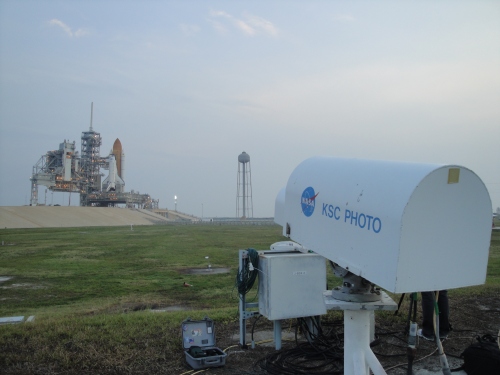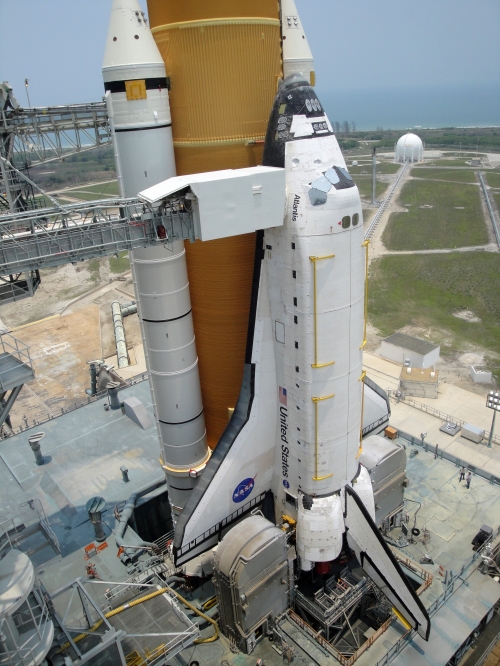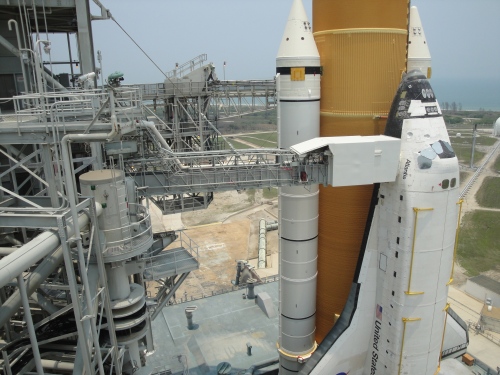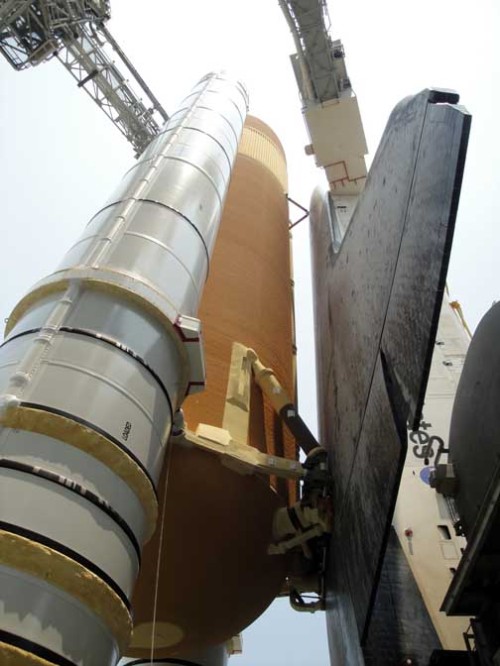 This former Header is the VAB from the Media Site on the afternoon of April 27. Not merely a cloud-filled afternoon, KSC was fighting ferocious fire just to the southwest of the media site which grayed things up for awhile quite nicely. To the left of the VAB and right of the water tower are two low buildings. They are the OPFs (hangars) for the shuttles — and while they may look small along side the VAB (which is 37 stories), they are not. The Orbiter Processing Facilities are huge buildings, like everything else at Kennedy Space Center. Scroll down and we’ll have a look at the shuttle Discovery inside one of these buildings.
This former Header is the VAB from the Media Site on the afternoon of April 27. Not merely a cloud-filled afternoon, KSC was fighting ferocious fire just to the southwest of the media site which grayed things up for awhile quite nicely. To the left of the VAB and right of the water tower are two low buildings. They are the OPFs (hangars) for the shuttles — and while they may look small along side the VAB (which is 37 stories), they are not. The Orbiter Processing Facilities are huge buildings, like everything else at Kennedy Space Center. Scroll down and we’ll have a look at the shuttle Discovery inside one of these buildings.
April 27, 2011, Wednesday
Kennedy Space Center
There’s a lot going on today — a tour of the old launch pad, 39-B, now being torn down; a walk along the SLF, the shuttle landing facility (to you and me: The Runway), and a walk around the shuttle Discovery, now residing in a hangar (the OPF: Orbiter Processing Facility), Bay 2. There are also interviews with several astronuats.
Things are humming.
KSC has re-named me. I have read the name on my credentials, although apparently no one else has. My name is now Michael Crow and I work for the TV station somewhere in the west. I know this because the first call letter of my station is a “K”. Stations west of the Mississippi, with a couple of exceptions in the early days of radio, got call letters starting with “K”. Those east of the Mississippi start with “W”. So why is there a station KDKA in Pittsburgh and a station WEW in St. Louis? They were among the first stations.

petecrow slounging again the daily countdown sign and, yes, that is the Vehicle Assembly Building (VAB) on the right.
Anyway.
I do not work for a TV station, and my middle name may be Michael, but NASA knows me as “Peter”.
I return to the badging station on State Road 3 to see if I can straighten it out. Happily they are open. They are not always open.
It developes that this is well worth the trip. The women running the badging station are of good cheer — “this happens an average of once every launch” one tells me as she digs for my credentials and, ultimately not finding anything, asks me to fill out the paperwork and show me two forms of ID (my driver’s license and passport suffice). Soon she is holding a credential with my proper name, and proper media affiliation attached.
She produces a punch and SNAP! punches a hole in the top of the credential so it can be pinned on whatever part of my body I wish with the exception that “it should be visible.” Fair enough, and I had not been intending to attach it to my underpants anyway.
“I punched some guys driver’s license instead of his badge one day,” a woman says.
What? What was that?
“He was pretty upset.” Apparently in some states a punched hole in your drivers license voids it.
The Tweeters.
Next door, the Tweeter badging station is now open. NASA has again invited 150 bloggers to come Tweet. Getting invited is straight-forward. For 24 hours anyone can apply (4,000 did this time) and then NASA randomly plucks out 150 names. Voila! You’re in …. and 3,850 of you are not.
This is the fourth time NASA has invited the Tweeters in. The first time was STS-129, and then NASA decided to think about it for awhile and tweak the tweeters. The Tweeters were invited back for STS-132, STS-133 and now for STS-134. Tweeters are allowed to come only once — if you got picked earlier, you don’t get to come back.

Welcome to TweetUp credentialing.Tweeters can get their credentials on T-2, but have to wait until T-1 to gain access. A big fire on T-2 looked like it was near the TweetUp Tent and might burn it down. The fire raged much of the afternoon of T-2 but never got too close to the Media Site.
The Tweeters are packed off to the far end of the Media site and put in a large tent. They are not welcome in the main media center and perhaps that is just as well. For STS-134 there will be 1,500 media and NASA has opened the overflow annex for additional workspace. We oursevles were packed off to the annex and put next to Scientific American, the BBC and some newspaper I could never pronounce in a thousand years.
I love the Tweeters. It is a zany idea to invite a random bunch of people in, and these days a bit of a security risk. Tweeters, like everyone else, get a thorough security frisk before being approved, but still … That’s way Tweeters find themselves at the far end of the media site surrounded by water and boxed in by jungle. If one of them makes a run for it, security can see them coming. If they decide to swim, the alligators will eat them.
The other reason they are where they are? Bathrooms.

KSC actually has two badging stations and it can get confusing. When events cause a heavy influx of media, media badging is moved to State Road 3. Media attendance will get heavier for STS-135, the final launch, but at 1,500 on STS-134 it is lenty heavy. The heaviest media coverage was probably the final Moon launch, Apollo 17. The heaviest I remember was 2,200 but I forget which mission that was. I think it was a Shuttle landing at Edwards Air Force Base in California.
Wait. Do they let the Tweeters use the bathrooms as the Media? Yes and No. Tweeters are free to pee in the large restrooms near the Tweet-Up grandstands. No peeing in the Media Center’s bathrooms.
Tweeters, unlike the Media, get a backpack full of free stuff. Pictures, and pins and — lots of stuff, including that backpack with the NASA logo on it. It is a handsome backpack.
“Where did all of this stuff come from?” I ask. A woman manning the Tweeter desk tells me “we scounged it”. You didn’t loot it? “No, we didn’t have to.” Looting is when something is sitting on a counter, say like the Boeing counter in the Media Cernter and they are like really busy talking to someone else so you take something off the pile without asking. Scounging is when you ask. The Tweet women have a fine job of scounging as far as I can tell.
I ask how long the Tweeters will be around and am surprised how brief their lifespan is. The Tweeters can begins picking up their credentials on T-2 (Wednesday, today) but are not allowed onto Kennedy Space Center or into the Tweeter tent until Thursday, T-1. And: “They are allow one delay.”

The TweetUp Tent is pretty much in the middle of nowhere. If a Tweeter decides to make a run for it, it's a long run to the road. If she decides to swim for it, the alligators will eat her. If a Tweeter decides to escape through the surrounding jungle, it's a pretty good bet he'll never be seen again.
If the Shuttle launches on Friday afternoon, April 29 as now expected, the Tweeters go home. They have been there T-1 and T-0, two days — tat’s it. But if, as often happens, the shuttle launch is delayed? “They get come back once but if it doesn’t launch the second time, that’s it.” Whoa — NASA is a tough crowd.
Tweeters pay their own way and while officially none are allowed to come back a second time, several Tweeters will be back for STS-134 from STS-133. When some of those whose name was drawn couldn’t come for STS-134, NASA didn’t have time to accredit anyone from the wait list so they invited several from STS-133 to return and see a launch bcause they’d already cleared security.
Have there been any problems with the Tweet-Up in the first three Tweet-Ups? STS-133 was delayed and delayed — “that was a problem.” But what about the Tweeters themselves? The Media is totally cowered; does NASA have their bluff in on the Tweeters? “We’ve had to take a couple out in the hall and threaten to send them to the principal’s office” but that was about it. No one has been paddled or had their Tweeter credentials cut in half — “and WE haven’t punched a hole in anybody’s driver’s license.”
The afternoon tours / Launch Pad 39-B
Today is a juicy day at the Cape for the Media. NASA is going to do briefings for the press at some places they rarely, if ever, have taken the press. Three buses will rotate through three separate sites.
Launch Pad 39-B. My bus first heads for Launch Pad 39-B which I learned a month or so ago is being torn down. That is true — but then again, it isn’t. Pad 39-B really is being re-purposed for a different use. In its first iteration it was on of the launch pads for the Apollo Moon program. Apollo 10 lifted off from here; this was the mission that circled the Moon, but did not land at Christmas 1968. The next mission, Apollo 11 actually landed.

Launch Pad 39-B on April 27, 2011. The structure is almost entirely gone and the demolition of the pad, on hold until after STS-134 launches, will resume after the launch. Pad 39-B is 8,000 feet -- roughly a mile and a half -- from Pad 39-A where STS-134 will launch.
Then 39-B was rebuilt as one of two launch pads for the shuttle, rotating with Pad 39-A. In the first 25 shuttle flights, when NASA was aggressively launching, both pad 39-A and 39-B were busy. Then in 1986, the Challenger was launched from 39-B; this pad was rarely used thereafter, if ever.
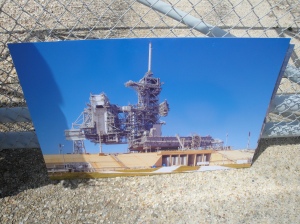
A photo of Pad 39-B in better days was leaning against the fence surrounding the launch complex on April 27, 2011.
With the shuttle program ending, NASA expected to develope Constellation, a new vehicle. So NASA began re-purposing Pad 39-B. But then Constellation was cancelled, and then it was re-instated. Then it was cancelled again. Now NASA is unclear how 39-B will be used, but the pad is being razed so it will be ready if Congress greenlights a new program.
The shuttles are moved along twin lanes of a high paved with loose river rock atop the five story crawlers. The crawlers literally crawl — roughly one mile per hour. In other times NASA has invited the press to walk with the crawler as it goes to the launch pad. In recent missions NASA has not offered the press that opportunity, although they have become more liberal about allowing the press to view the rollout of the shuttle from the VAB (Vehicle Assembly Building).
Discovery in Bay 2 of the Orbiter Processing Facility (OPF). The OPF is the hanger. Each shuttle when it returns to Kennedy is dragged from the landing strip, known as the Shuttle Landing Facility (SLF) back to one of three hangars. The hangars are inter-changeable although there are slight differences in the designs of their doors and possible other minor differences.

Right wing, Shuttle Discovery, Hi-Bay 2, Orbiter Processing Facility (OPF), Kennedy Space Center, April 27, 2011. Discovery is headed to the Smithsonian outside Washington, DC early in 2012.
In the OPF, a shuttle is essentially surrounded by a cocoon of wires and tubes and mteal stairs and walkways. When the shuttle returns it must be re-processed for the next flight. Tiles had to be replaced. The entire vehicle was inspected. A ton of work was needed to ready it for the next flight.
Now, however, the shuttle Discovery, the oldest surviving member of the shuttle fleet, has completed its final mission.
Today it is being readied for turnover to the Smithsonian. Sometime early next year, probably in February, Discovery will be flown a final time atop a Boeing 747 to Dulles Airport at Chantilly, Virginia (west of Washington, DC) and come to rest in the air and space museum at Dulles.

One of two rear landing wheels on Discovery.
The other shuttles will head to Los Angeles and New York. And one will remain in Florida at KSC.
The shuttle currently displayed at the Smithsonian was a test vehicle and never flew in space. This vehicle is the vehicle that will be moved to New York.
Visiting the OPF is interesting if confusing. Somewhere inside the jumble of cables and steel is the Discovery, but only glimpses are possible. Over there is the part of the sign that reads “United States”. At the very front, the nose cone and front wheel well, and wheel are visible. To know what you are seeing, largely you have to know what to look for.
But in coming years if anyone asks if I ever visited the shuttle hangars, the answer will be Yes, although I probably won’t bother to add that I wasn’t quite sure what, besides the underbelly, the tires and the tiles I saw when I was there.
The Shuttle Landing Facility (SLF). The SLF is the huge long runway where the shuttles land when returning to Kennedy Space Center.

Closeup of the grooves on the SLF that run from side-to-side across the runway. No, I did not step on the SLF to take this picture. Geech. Grooves deflect water and give greater traction. Commercial airport runway now are grooved, as are an increasing number of highways.
This was the third and final stop on our afternoon tour, and the purpose was largely to talk about what will happen to KSC now that thye shuttle program is ending. Clearly, there’s much concern that nothing much will happen here — and that is not a new event. Following the Moon program, Apollo, there was little else in the pipeline. Jobs vanished. The wider area struggled financially.
During the 1970s during this relatively dark period, NASA flew the joint program with the Russians, and Skylab which burned up in the atmosphere before the shuttle became operational. Yes, we have had an international space station in orbit before.

Pete stands on shoulder of the Shuttle Landing Facility halfway down the runway. The actual runway is on the right. The VAB in the distance is on the left. Out of frame on the left is a sign that reads "7". It one of the distance markers allowing pilots when landing or taking off to know where they are in relation to the end of the runway.
The peak of employment at Kennedy was during the Apollo program with about 24,000. The shuttle program and related activities employed about 14,000. With the end of the program employment here is expected to drop by 50-percent or more to 7,000.
Mid-stride of the SLF are the grandstands and the tower. Here the press and VIPs watch the shuttle land — although NASA on STS-133 and perhaps other missions allowed the press to photograph the landing from the end of the runway.
NASA is anal about people walking on the SLF. The media was warned repeatedly that if they stepped onto the runway, they risked have their credentials pulled. The reason? Anything on a runway risks being sucked into aircraft engines. That’s what happened to the Concorde causing it to crash in Europe.
. . . . . . .
copyright blahblahblah legalese // Readers are reminded that “petecrow/NASA” blog is legal property of Seine/Harbour® Productions, LLC, Studio City, California.
 The literary content, and the photographs, are © 2011 by Seine/Harbour® Productions, LLC and by Peter Michael Crow. Happily, we have proven to be ominously successful in discovering abridgements of our copyrights and in winning financial settlements against you and you and … You.
The literary content, and the photographs, are © 2011 by Seine/Harbour® Productions, LLC and by Peter Michael Crow. Happily, we have proven to be ominously successful in discovering abridgements of our copyrights and in winning financial settlements against you and you and … You.
Read Full Post »
 Until May, NASA thought they were tearing down Pad 39-B to re-purpose her for the Constellation program. Then, for a second time, just as the new spaceship was about to be manufactured, Obama canceled it. Millions were wasted.
Until May, NASA thought they were tearing down Pad 39-B to re-purpose her for the Constellation program. Then, for a second time, just as the new spaceship was about to be manufactured, Obama canceled it. Millions were wasted.
